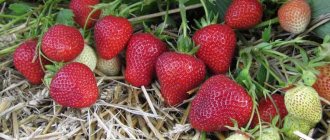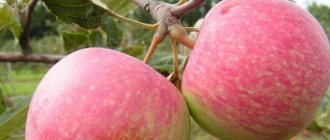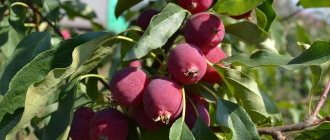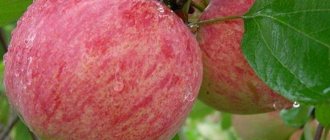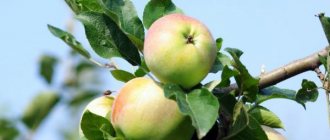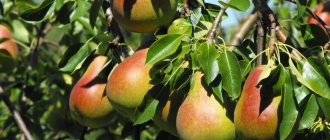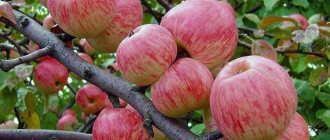The Narodnoe apple tree is an intensive variety with early autumn fruit ripening . He was bred at VNIIS named after I.V. Michurin under the guidance of Professor S.I. Isaev.
, the Papirovka and Bellefleur-Chinese varieties were crossed
The purpose of selection was to improve the characteristics of Papirovka: increasing resistance to scab and consumer value of the fruit, increasing shelf life.
From Bellefleur the Chinese, the apple received
a delicate dessert taste . S. And Isaev, the creator of the apple tree, called Narodnoye the most delicious of the 40 varieties he created. This article presents a photo and description of the variety so that you can decide on the possibility of growing it. Important! The variety was included in the State Register in 1964 and is recommended for cultivation in the Central and Middle Volga regions of Russia.
Characteristic
Tree height
A tree of medium vigor , with a rounded, slightly spreading crown. The variety belongs to the semi-dwarf species of apple tree; The height of an adult tree does not exceed 4.5 meters . The width of the crown is commensurate with the height and reaches 4-4.5 meters in diameter.
Apple tree Popular.
Branches and trunk
They have a brown color. The shoots are straight, thick, grow sparsely, without thickening the crown.
Annual shoot growth
Equal to 35-45 cm.
Leaves
Light green in color, broadly ovoid or elongated in shape. The leaf blade is medium in size with a wavy, crenate edge.
Fruit
Regular round shape , medium size (110-140 g for an adult tree, 170-200 for a young tree). Some apples have a narrow dividing seam like the White Naliv variety.
The fruit of the Popular apple tree with a dividing seam.
The skin of an apple has numerous and small subcutaneous points . When ripe, the fruits are green-yellow. At consumer ripeness, their color changes to golden yellow.
Pulp
Yellowish-green, juicy, aromatic, with a sweet and sour dessert taste . Chemical composition of fruits:
- Dry matter - 13%;
- Ascorbic acid - 7.7 mg/100 g;
- Sugars – 11.4%;
- Tetratable acids – 0.4%.
Tasting evaluation of fruits
4.5-4.75 points.
Productivity of the variety
Tall, reaches 160 kg from an adult tree .
Winter hardiness
The winter hardiness of the variety is good, reaching – 30 °Ϲ .
The Narodnoye apple tree has good winter hardiness.
Disease resistance
Average , for scab fungus - above average.
Advice! If you need large fruits from a mature tree, remove a third of the ovaries from it. The number of fruits will decrease and the weight will increase.
Reviews
Evgenia S, Chelyabinsk. ‟ I’m very glad that I chose this variety of apple tree, because before buying I looked at its description and photo for a long time! She pleased me with the first apples in the second year! Now she is 10 years old and I remove 10-15 buckets from her in September. The apples themselves are even, smooth and very tasty! The only downside is that wasps love it. If you leave a bitten apple on the table, they will flock to it and want to finish it))”
Victor Timofeevich, Togliatti. “The folklore has been growing with me for about 15 years now, and I have formed a personal opinion about it. It has many advantages: it quickly begins to bear fruit, yields, and a convenient tree shape. The apples, although not very large, are pleasant to taste. The drawback for me personally is that the apple itself has no blush and is not bright. The wife sells at the market, and the first to go are beautiful apples like Pepin Saffron, although Narodnoe is tastier than it. ”
Tatyana Aleksandrovna M, Voronezh. ‟ Many on the forum praise this variety, and I will join. In addition to all the stated advantages, this variety is convenient for novice gardeners. The crown of the tree grows sparsely, so it does not require frequent pruning. It will have to be pruned at 25-30 years of age, when the frequency of fruiting begins. ”
Landing Features
Deadlines
The best time to plant a Narodnoye apple tree is autumn, from the end of September to mid-October . This variety is frost-resistant and does not require long adaptation before winter temperatures drop.
When planting in spring ( from mid-April to mid-May ), it is important to water the plant on time so that the fragile seedling can get used to new living conditions.
For the Narodnoe apple tree, autumn planting is preferable.
Technology
Well-lit areas with fertile and breathable soils are suitable for the Narodnoe apple tree . The distance between other trees should be at least 2.5-3 meters.
5 important rules when planting any apple tree:
- Before planting, soak the roots of the seedling in water for 5-6 hours.
- Dig a hole wider and deeper than the root system of the seedling by 30-40 cm.
- Bury all “planting” fertilizers below the roots or dissolve them in water for irrigation.
- Be sure to tie the seedling to a peg, preferably using the figure-of-eight method.
- Trim apple tree branches to a third of their length.
Advice! The best way to garter a seedling is to three pegs at once! A tree that does not sway in the wind will take root faster!
Watch a video on how to plant apple trees correctly:
Harvest storage rules
The early autumn apple tree produces a harvest in late August or early September, depending on the climatic conditions of the region. Shelf life in a cool room is until January.
Fruits are usually stored in wooden boxes or wicker baskets that allow oxygen to pass through well.
The best place is considered to be a basement or cellar. There is no direct sunlight in this room and there is good ventilation. A small amount of fruit can be placed in the refrigerator, where their shelf life is extended by another 1-2 months.
Care
Trees of this variety are unpretentious and do not require special care. Those gardeners who want to achieve special productivity need to water and fertilize the apple tree on time, protect the tree from pests and diseases .
Pruning and crown formation
The Narodnoye apple tree variety does not tend to thicken the crown , and in ordinary gardens does not require annual pruning. It produces a good harvest in its natural, wide-round form.
When pruning, diseased, broken and damaged branches are removed. If the tree has weak branches, in late spring or early autumn its side branches are shortened by a third, making a cut after the bud, looking in the direction “from the trunk”.
The Narodnoe apple tree requires only sanitary pruning.
Watch a detailed video tutorial on pruning and crown formation:
Watering mode
The watering schedule for a tree primarily depends on its age:
- Seedlings of the first year of planting need to be watered with 2 buckets of water once every 10-14 days (if the weather is dry);
- Adult apple trees are watered less often, but use more moisture for this, watering the entire ground under the crown;
- a tree 8-15 years old 4-5 times per season, using 10-15 buckets of water.
Important! In the fall, before the onset of frost, the apple tree needs moisture-recharging irrigation at the rate of 45-50 liters of water for each square meter of soil under the crown. If the summer and autumn were rainy, the amount of water is reduced by 1.5 times.
Feeding
An optional condition for successful cultivation. This variety is undemanding to the chemical composition of the soil :
- Spring nitrogen fertilizing is carried out when shoot growth is weak;
- Autumn phosphorus-potassium - to increase yields or when switching to the periodicity of fruiting of mature trees.
When fruiting occurs periodically, apply phosphorus-potassium fertilizers.
How and with what to fertilize apple trees correctly, watch the video below:
Features of ripening and fruiting
Precociousness
The Narodnoe apple tree belongs to the group of especially early-fruiting varieties . It can bloom the next year after planting and produce a harvest of 3 kg of apples in the 3rd year. It is better to pick off the first flowers on the apple tree so that such an early start of fruiting does not detract from the forces needed to grow roots and shoots.
Pollination
Another advantage of Narodny over other varieties of apple trees is its self-pollinating ability. This tree bears fruit:
- In hot weather and in rain;
- When the flight of bees stops;
- In the absence of other flowering apple trees nearby.
This remarkable property allows the gardener not to worry about natural disasters during flowering.
Productivity
The yield of the variety is 140-170 kg per mature tree . Considering that the apple tree itself is small, semi-dwarf in size, its fertility is considered high. According to the observations of Doctor of Agricultural Sciences I. S. Isaeva (daughter of the creator of the variety), the yield of the semi-dwarf Narodnoye is equal to the yield of the tall Antonovka tree.
Fruit ripening and storage times
The Narodnoe apple tree is an early autumn variety , ripening from late August to early September (10 days later than Papirovka). This apple tree is one of the rare autumn varieties capable of long-term storage. Fruits with intact skin are stored until January!
Folk items can be stored until January.
Watch a video tip on how to preserve apples for the winter:
Diseases and pests
This type of crop has good immunity to fungal diseases, in particular scab. Despite this, prevention of the disease should not be neglected. As a preventive treatment in the spring, before the leaves bloom, apple trees are sprayed with a 1% solution of copper sulfate (100 g of substance per 10 liters of water) or the drug Oksikhom.
Hybrid trees may suffer from:
- powdery mildew, characterized by the appearance of a white coating on the leaves, buds and shoots, as a result of which parts of the plants dry out and fall off. Affected flowers do not produce apples. If the disease occurs on already set fruits, they subsequently crack and become deformed. Such fruits become inedible and unsuitable for food. To prevent disease, trees are treated several times with a 1% solution of Bordeaux mixture (100 g of copper sulfate and 150 g of lime per 10 liters of water). The first spraying is done before the buds swell, the apple trees are treated the second time before flowering, and the third time immediately after it;
- bacterial burn (bacteriosis), the signs of which are necrotic areas on leaves, shoots and bark. In addition to the fungicides Fitolavin, Acrobat or Skor, the disease is treated with conventional pharmaceutical antibiotics - Ampicillin or Gentamicin.
Although Narodnoye is quite resistant to pest attacks, there is still some probability of them damaging apple trees. Trees may be damaged by:
- aphids;
- codling moths;
- red tick.
Insecticides Inta-vir, Skor, Iskra, Karbofos or Nitrafen will help cope with this scourge.
Aphids on an apple tree.
Apple tree Popular on a dwarf scion
Natural semi-dwarf Narodnoe can be grafted onto a dwarf rootstock. This measure is needed to create especially compact trees that can grow in areas with high groundwater levels . For the Narodnoye variety, such rootstocks are rarely used, because this variety already has the advantages of dwarf apple tree species: early fruiting, high yield and small size.
Attention! The Narodnoe seedling on a dwarf rootstock requires special care. It needs to be watered, pruned every year and fertilized 2-3 times per season.
Advantages and disadvantages
The Narodnoye variety has many advantages:
- frost resistance (survives winters even at minus 30 degrees);
- self-fertile (easily pollinated without the influence of insects and other trees);
- has a small size, which makes it easier to care for;
- precociousness (the first harvest can be obtained within a year);
- taste;
- even young trees produce a large volume of harvest;
- fruits are suitable for any method of consumption and processing;
- long shelf life (six months without 50 days);
- resistance to many crop diseases.
But it was not without its drawbacks:
- lack of bright color;
- mature trees may bear fruit irregularly;
- late ripening time for apples.
Growing in regions
The Narodnoye apple tree variety is recommended for cultivation in the Central region , which includes Moscow and the Moscow region. Despite the average winter hardiness of the variety (up to -30 °Ϲ), the seedlings are covered for the winter in the first year after planting.
The Narodnoe apple tree grows well in the Central region.
In the Urals and North-West Russia, the tree is more susceptible to freezing of annual growth, especially shoots that have not ripened to persistent frosts. In order for the tree to feel comfortable, for planting you need to choose areas protected from cold northern winds . It is recommended to cover young trees for the first 2-3 years after planting.
History of the variety's creation
The early autumn hybrid Narodnoye gained fame in 1937. It was then that at VNIIS named after I.M. Michurina Professor S.I. Isaev and a group of scientific breeders, by crossing Papirovka and Bellefleur-Chinese, developed a new variety of apple tree with high yields and survival rates.
The main goal of the biologists’ work was to improve the consumer value and increase the shelf life of the Papirovka variety. That is why the pair added the Bellefleur Chinese dessert apple tree, famous for its delicate, refined taste. As a result, the Narodnoye apple tree variety appeared.
The hybrid under this name was included in the State Register in 1964. Due to its varietal characteristics, it takes root best and bears fruit consistently in regions with a continental climate: the Central and Middle Volga regions of Russia.
Useful tips
- Remove all growth growing below the grafting site! These branches are the rootstock of the apple tree, which does not have the properties of the variety you purchased;
- Do not forget to whiten the tree in late autumn - you will protect it from sunburn in the spring;
- When buying an apple tree, choose a low seedling with well-developed small (sucking) roots, a strong trunk and 2-5 branches . Tall and thin 2-3 year old seedlings are grown in the southern regions, with a large amount of nitrogen fertilizing. They do not take root well in regions with cold climates and freeze out in the first 2-4 years.
